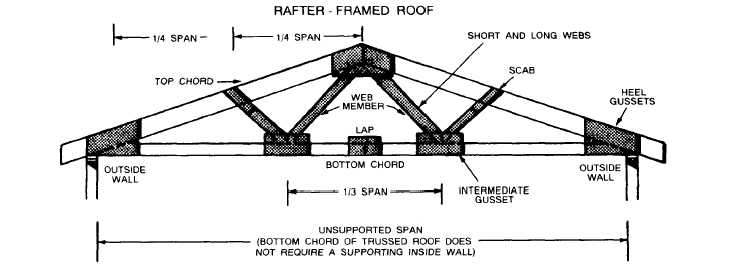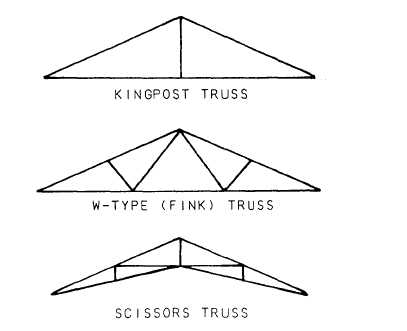
Figure 2-4. - A truss rafter.
The engineer works with the architect to decide what materials to use in the structure and the construction methods to follow. The engineer determines the loads that supporting members will carry and the strength qualities the members must have to bear the loads. The engineer also designs the mechanical systems of the structure, such as the lighting, heating, and plumbing systems. The end result is the architectural and engineering design sketches. These sketches guide draftsmen in preparing the construction drawings.
CONSTRUCTION DRAWINGS
Generally, construction or "working" drawings furnish enough information for the Builder to complete an entire project and incorporate all three main groups of drawings-architectural, electrical, and mechanical. In drawings for simple structures, this grouping may be hard to discern because the same single drawing may contain both the electrical and mechanical layouts. In complicated structures, however, a combination of layouts is not possible because of overcrowding. In this case, the floor plan may be traced over and over for drawings for the electrical and mechanical layouts.
All or any one of the three types of drawings gives you enough information to complete a project. The specific one to use depends on the nature of construction involved. The construction drawing furnishes enough information for the particular tradesman to complete a project, whether architectu- ral, electrical, or mechanical. Normally, construction drawings include the detail drawings, assembly drawings, bill of materials, and the specifications.
A detail drawing shows a particular item on a larger scale than that of the general drawing in which the item appears. Or, it may show an item too small to appear at all on a general drawing.
An assembly drawing is either an exterior or sectional view of an object showing the details in the proper relationship to one another. Assembly drawings are usually drawn to a smaller scale from the dimensions of the detail drawings. This provides a check on the accuracy of the design drawings and often discloses errors.
Construction drawings consist mostly of right- angle and perpendicular views prepared by draftsmen

Figure 2-5. - The most commonly used roof trusses.
Continue Reading